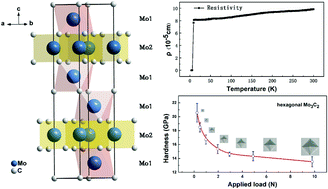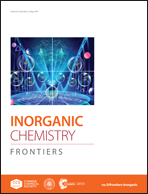Superconductivity with high hardness in Mo3C2†
Abstract
Inserting light element atoms into a transition metal host matrix simultaneously produces high hardness and high superconductivity transition temperature. Here, we report the synthesis of a polycrystalline ‘covalent metal’ – Mo3C2 (with space group: P63/mmc) with the high pressure and high temperature (HPHT) method. Direct magnetic susceptibility and electrical resistivity measurements show that Mo3C2 is a typical weakly coupled type-II superconductor with a high critical magnetic field and a superconductive temperature of 8.2 K. Moreover, compared with traditional superconductive materials, the asymptotic Vickers hardness value of Mo3C2 shows impressive high hardness. Its high superconductive temperature originates from its high Debye temperature and high density of states at the Fermi energy level. The high Debye temperature is closely correlated with the hybridization between Mo-4d orbitals and C-2p orbitals, and the metallic feature leads to the high density of states at the Fermi energy level N(EF). The advent of this class of high hardness superconductive materials bridges the gap between high hardness and superconductivity communities.



 Please wait while we load your content...
Please wait while we load your content...